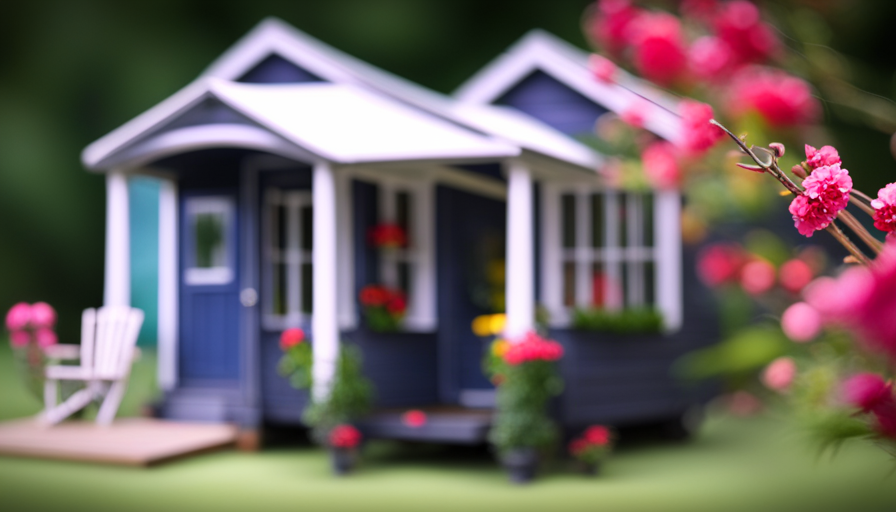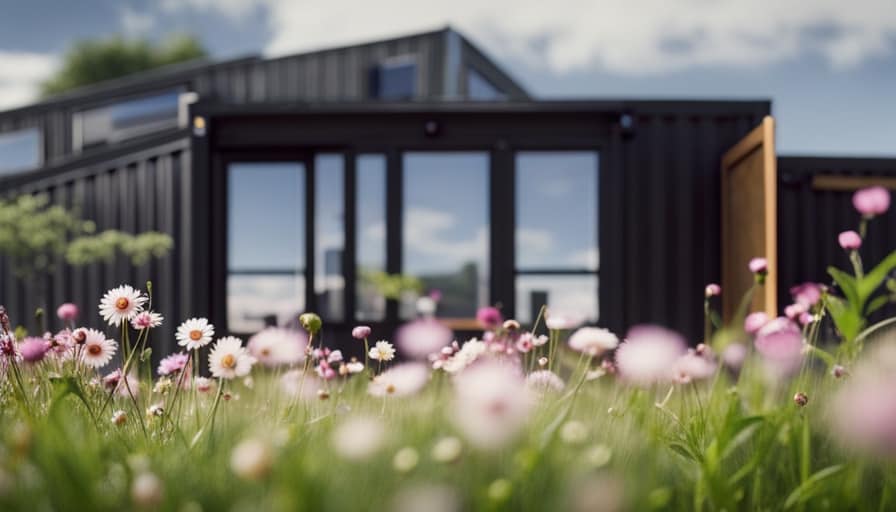As a passionate advocate for tiny house living, I understand the challenges that come with navigating zoning regulations. Recently, I came across a case study that highlights the importance of addressing zoning issues for tiny houses.
Sarah, a young professional, dreamed of downsizing and simplifying her life by building a tiny house on a piece of land she owned. However, she soon discovered that her local zoning regulations prohibited such dwellings. Frustrated and discouraged, Sarah began searching for solutions and stumbled upon a wealth of resources that helped her navigate the complex world of zoning laws.
In this article, I will share my knowledge and expertise on how to find answers to tiny house zoning questions. By understanding the basics of zoning laws, researching local codes, consulting with professionals, joining tiny house communities, utilizing online resources, considering alternative living options, seeking variance or exemption, and staying informed and updated, you can overcome zoning obstacles and make your tiny house dreams a reality.
Key Takeaways
- Research local zoning codes and understand the basics of zoning laws before pursuing a tiny house living option.
- Consult with professionals such as land use attorneys, zoning consultants, and tiny house builders/advocates for guidance and advice.
- Utilize online resources, websites, forums, and social media groups to gather knowledge and connect with others who have experience with zoning challenges.
- Attend local government meetings, explore tiny house communities, and consider RV parks and campgrounds as potential legal options for tiny house living.
Understand the Basics of Zoning Laws
Don’t let zoning laws scare you away from your dream of a tiny house – understanding the basics will empower you to navigate the regulations with confidence! Researching regulations and understanding the legal requirements is crucial when it comes to building a tiny house.
Zoning laws are put in place by local governments to regulate land use and ensure that certain standards are met. These laws dictate where and how you can build your tiny house, so it’s important to familiarize yourself with them.
To begin, research local zoning codes specific to your area. These codes will outline the rules and restrictions for building and living in a tiny house. Pay attention to zoning designations, as they determine the type of structures allowed in each area. Additionally, familiarize yourself with setback requirements, which dictate the distance your tiny house must be from property lines or other structures. Other important factors to consider include minimum square footage requirements, utility connections, and parking regulations.
By understanding the basics of zoning laws and researching local zoning codes, you will have the knowledge and confidence to tackle your tiny house project. This information will guide you through the legal requirements and help you find the answers to your zoning questions.
Research Local Zoning Codes
Explore your local zoning codes to gain insight on regulations in your area for building and living in a tiny house. Researching local zoning codes is an essential step in understanding the basics of zoning laws and ensuring that you comply with the regulations specific to your location. By taking the time to thoroughly examine these codes, you can avoid potential legal issues and ensure that your tiny house project is feasible.
To help you navigate through the complex world of zoning regulations, I have created a table that outlines the key factors to consider when researching local zoning codes for your tiny house:
| Factors to Consider | Explanation | Importance |
|---|---|---|
| Permitted Use | What is allowed? | Determines feasibility |
| Setback Requirements | How far from | Affects building design |
| property lines must you | ||
| place your tiny house? | ||
| Minimum Square | How big can your | Impacts design options |
| Footage | tiny house be? | |
| Parking Requirements | Do you need to | Affects availability of |
| provide parking spaces? | suitable land | |
| Building Codes | What construction | Ensures structural and |
| standards must be met? | safety requirements are | |
| followed |
By referring to this table, you can gain a comprehensive understanding of the specific regulations that apply to your tiny house project. Once you have familiarized yourself with the local zoning codes, you can consult with a professional to further clarify any questions or concerns you may have.
Consult with a Professional
When it comes to navigating the complex world of local zoning codes for tiny houses, I highly recommend consulting with a professional. Hiring a land use attorney or zoning consultant can provide you with expert guidance and ensure that you are making informed decisions.
Additionally, seeking advice from a tiny house builder or advocate can provide valuable insights and practical solutions based on their experience in the field. By tapping into the expertise of these professionals, you can confidently address any zoning questions or concerns you may have and make informed decisions for your tiny house project.
Hire a land use attorney or zoning consultant
Consider hiring a land use attorney or zoning consultant to ensure your tiny house dreams become a reality without any legal obstacles standing in your way.
Land use regulations and zoning permits can vary greatly from one area to another, and it’s crucial to have a professional who understands the intricacies of these laws.
A land use attorney or zoning consultant will have the expertise to navigate through the complex process of obtaining the necessary permits for your tiny house. They can provide valuable advice on zoning restrictions, setback requirements, and other legal considerations that may affect your project.
By working with a professional, you can save time, money, and avoid potential legal issues down the road. With their guidance, you can confidently move forward with your tiny house plans.
Seeking advice from a tiny house builder or advocate can also provide valuable insights into the practical aspects of building a tiny house.
Seek advice from a tiny house builder or advocate
Engage with a tiny house builder or advocate to gain valuable insights and glide smoothly through the process of turning your tiny house dreams into reality, like a skilled sailor navigating uncharted waters.
These professionals have extensive knowledge and experience in dealing with tiny house zoning regulations and tiny house building codes. They can provide you with guidance on how to navigate the complex world of zoning laws, ensuring that your tiny house meets all the necessary requirements. They can also help you understand any potential challenges or obstacles that you may face during the zoning process and offer solutions to overcome them.
By seeking advice from a tiny house builder or advocate, you can save yourself time and frustration by tapping into their expertise.
Transitioning into the subsequent section, joining tiny house communities can also provide valuable insights and support in navigating tiny house zoning questions.
Join Tiny House Communities
Joining tiny house communities can be a great way to find answers to zoning questions and connect with like-minded individuals in the process. These communities are made up of people who are passionate about tiny house living and can provide valuable insights and advice. Here are three reasons why joining a tiny house community can be beneficial:
-
Networking: By joining a tiny house community, you gain access to a network of individuals who’ve already navigated the challenges of zoning regulations. They can offer guidance based on their own experiences and connect you with local resources and contacts.
-
Support and Resources: Tiny house communities often have online forums or social media groups where members can ask questions and share information. This can be a valuable resource for finding answers to specific zoning questions and learning about alternative housing options.
-
Learning Opportunities: Many tiny house communities organize events, workshops, and meetups where you can learn more about tiny house living and zoning regulations. These events often feature experts in the field who can provide valuable insights and advice.
By joining a tiny house community, you can tap into a wealth of knowledge and experience that can help you navigate the complexities of zoning regulations. Once you’ve explored the benefits of these communities, the next step is to utilize online resources to further enhance your understanding of tiny house zoning.
Utilize Online Resources
Utilize online resources to unlock a virtual treasure trove of knowledge and guidance, like a GPS guiding you through the intricate maze of tiny house zoning regulations. The internet is packed with valuable information and tools that can help you find answers to your specific zoning questions.
Online resources such as websites, forums, and social media groups dedicated to alternative living options can be incredibly useful in navigating the complex world of tiny house zoning. Websites like Tiny House Community and Tiny House Talk provide comprehensive guides and articles that cover various aspects of tiny house living, including zoning regulations. These resources often break down zoning laws by state or city, offering detailed information on what is allowed and what is not.
Additionally, online forums and social media groups allow you to connect with others who are passionate about tiny houses and can share their experiences and insights on navigating zoning challenges. By utilizing these online resources, you can gain a better understanding of the specific zoning regulations in your area and learn from the experiences of others who have gone through the process.
Armed with this knowledge, you can confidently attend local government meetings and engage in discussions about tiny house zoning, knowing that you are well-informed and prepared.
Attend Local Government Meetings
By attending local government meetings, you can actively participate in shaping the future of alternative living options and gain valuable insights into the policies and regulations that affect your desired lifestyle.
Local government meetings provide a platform for community members to voice their concerns, share ideas, and influence decision-making processes. This is an excellent opportunity to connect with like-minded individuals who are also interested in exploring alternative housing options such as tiny houses.
During these meetings, you can learn about existing zoning laws and regulations that may impact your ability to live in a tiny house. You can also find out about any upcoming changes or discussions regarding alternative housing options. By actively engaging in these meetings, you can contribute to the conversation and advocate for more inclusive zoning policies that accommodate tiny houses.
Attending local government meetings allows you to directly interact with policymakers and get a better understanding of their perspectives and priorities. You can ask questions, raise concerns, and propose solutions. Building relationships with local officials and demonstrating your commitment to alternative living options can help create a supportive environment for tiny house enthusiasts.
Considering alternative living options requires a comprehensive understanding of the regulatory landscape and the opportunities available.
Consider Alternative Living Options
When it comes to finding answers to zoning questions about tiny houses, one alternative living option to consider is exploring tiny house communities or eco-villages. These communities often have specific regulations and guidelines in place that make it easier to navigate the zoning process for tiny homes.
Another option to explore is looking into RV parks or campgrounds that allow tiny homes. Many of these parks have designated areas or hookups for tiny houses, making it a convenient and legal option for tiny house living.
Explore tiny house communities or eco-villages
Imagine living in a close-knit community of charming tiny houses nestled amongst lush greenery and surrounded by like-minded individuals who share a passion for sustainable living. Exploring tiny house communities or eco-villages is a great way to immerse yourself in the world of sustainable living and alternative housing models.
Here are four reasons why you should consider this option:
-
Community Support: Living in a tiny house community offers a strong sense of belonging. You’ll have neighbors who understand and support your lifestyle choices.
-
Shared Resources: Many tiny house communities have shared amenities like communal gardens, common spaces, and workshops, allowing for a more efficient use of resources.
-
Learning Opportunities: Being part of a community means you can learn from others’ experiences and gain valuable knowledge about sustainable living practices.
-
Networking: Tiny house communities often organize events, workshops, and gatherings, creating opportunities to connect with like-minded individuals and expand your network.
By exploring tiny house communities, you can take a step towards sustainable living and alternative housing models. Look into RV parks or campgrounds that allow tiny homes to continue your exploration.
Look into RV parks or campgrounds that allow tiny homes
Consider researching RV parks or campgrounds that accommodate tiny homes, as these locations can provide a unique and convenient opportunity to experience sustainable living in a community setting. When exploring RV park options, it’s important to familiarize yourself with their specific regulations regarding tiny homes.
Some parks may have restrictions on the size, design, or duration of stay for tiny houses. It’s crucial to thoroughly review these regulations before making any decisions. Additionally, it’s worth noting that some campgrounds may offer more flexibility in terms of zoning requirements compared to traditional residential areas. This could potentially open up more possibilities for finding suitable locations for your tiny home.
As we move forward, it’s essential to consider seeking variance or exemption to further explore the zoning options available for tiny homes.
Seek Variance or Exemption
To seek a variance or exemption for building a tiny house, it’s crucial to understand the process involved. This includes researching the specific requirements and regulations for variances or exemptions in your local area.
Consultation with local authorities is essential to determine the feasibility of this option and to gather all the necessary information and paperwork needed for the application process. It’s important to be knowledgeable about the specific laws and regulations in order to successfully navigate through this process.
Understand the process of obtaining a variance or exemption
If you’re looking for a way to navigate the complexities of tiny house zoning, understanding how to obtain a variance or exemption can be your key to success.
The variance process and exemption process are two potential avenues for obtaining permission to build or live in a tiny house in an area that may not typically allow it. The variance process involves requesting a deviation from the existing zoning regulations, while the exemption process seeks to exempt the tiny house from specific requirements.
Both processes require thorough research, preparation of necessary documents, and presenting a strong case to the local authorities. It’s important to consult with local authorities on the feasibility of this option, as they can provide guidance on the specific requirements and likelihood of success in your area.
Transitioning into the subsequent section, it is essential to gather as much information as possible before proceeding with the variance or exemption process.
Consult with local authorities on the feasibility of this option
Now that I understand the process of obtaining a variance or exemption, it’s time to consult with local authorities on the feasibility of this option.
Before moving forward, it’s crucial to consider the local regulations and understand if obtaining a variance or exemption is even possible in my area. I will reach out to the local zoning department or planning commission to get their input and guidance. They will be able to provide me with valuable information regarding the specific requirements and restrictions that apply to my situation.
By consulting with these local authorities, I can ensure that I’m making informed decisions and avoid any potential legal issues down the line. Once I have gathered all the necessary information, I’ll be better prepared to navigate the process and be prepared for compromises in order to make my tiny house dream a reality.
Be Prepared for Compromises
Get ready to make some compromises when it comes to tiny house zoning questions. Zoning regulations can be strict and may require you to adjust your plans or expectations. Here are a few things to consider:
-
Size limitations: Many zoning regulations have minimum size requirements for residential dwellings. Your dream tiny house may need to meet these requirements or be classified as an accessory dwelling unit.
-
Placement restrictions: Zoning regulations may dictate where you can place your tiny house. It may need to be on a permanent foundation or in a designated tiny house community.
-
Utilities and infrastructure: Zoning regulations often require connection to utilities such as water, sewage, and electricity. Make sure your tiny house can comply with these requirements.
-
Community concerns: Some local authorities may have concerns about the impact of tiny houses on the neighborhood. Be prepared to address these concerns and work with the community to find solutions.
It’s important to stay informed and updated on zoning regulations as they can change over time. This will help you navigate the process and ensure that your tiny house is compliant with local regulations.
Stay Informed and Updated
Staying informed and updated on zoning regulations is crucial to avoid any surprise changes that could potentially derail your tiny house dreams. As someone who has gone through the process of navigating zoning regulations for my own tiny house, I understand the importance of staying on top of any changes or updates that may occur. To help you stay informed and keep up to date, I’ve created a handy table below with a list of resources and strategies that can help you find the answers to your tiny house zoning questions.
| Resource/Strategy | Description |
|---|---|
| Local Planning Department | Contact your local planning department to inquire about the specific zoning regulations for tiny houses in your area. They will be able to provide you with the most accurate and up-to-date information. |
| Online Forums and Communities | Join online forums and communities dedicated to tiny house living. These platforms often have discussions and threads about zoning regulations, and members can share their experiences and knowledge. |
| Tiny House Associations | Connect with local or national tiny house associations. They often have resources and contacts that can help you navigate zoning regulations. |
| Tiny House Workshops and Events | Attend workshops or events focused on tiny house living. These events often include sessions on zoning and legal considerations, providing you with valuable information and insights. |
By utilizing these resources and strategies, you can stay informed and up to date on zoning regulations, ensuring that you can navigate the process with confidence and clarity. Remember, knowledge is power, and staying informed will help you overcome any obstacles that may come your way.
Frequently Asked Questions
What is the average cost of building a tiny house?
The average cost of building a tiny house can vary depending on several factors. However, it typically ranges between $20,000 to $50,000.
Financing options for tiny house construction include personal loans, RV loans, and even crowdfunding platforms. It’s essential to consider your budget, desired features, and materials when estimating the cost.
Detailed planning and research can help you find the best financing option and ensure that your tiny house project stays within your budget.
Are there any specific requirements for the size of a tiny house?
Specific size requirements for tiny houses vary depending on the local regulations and zoning laws. Tiny house size regulations typically dictate the maximum square footage, height, and number of rooms allowed. It is important to research and consult with local authorities or zoning departments to ensure compliance with these requirements.
Additionally, building codes may also impact the size and design of a tiny house, so it’s crucial to familiarize oneself with these codes as well.
Can I legally live in a tiny house on wheels in my desired location?
Living in a tiny house on wheels in my desired location is subject to the legality of tiny house living. Some areas have specific zoning regulations that may prohibit or restrict the use of tiny houses as permanent residences.
Finding tiny house friendly locations can be challenging due to these zoning restrictions. It’s advisable to research local laws and regulations, consult with local authorities, and join online communities to gather information and insights from others who’ve navigated these challenges.
What are the common challenges faced when obtaining a building permit for a tiny house?
Obtaining a building permit for a tiny house can present several challenges. Firstly, understanding and complying with the specific zoning regulations in your desired location is crucial. It involves researching the local building codes and ordinances to ensure your tiny house meets the requirements.
Secondly, navigating the permit application process can be complex, as it may involve submitting detailed plans, inspections, and fees.
Overall, it’s important to be well-informed and prepared to tackle these challenges when obtaining permits for a tiny house.
Are there any specific restrictions on the utilities and systems in a tiny house, such as water, electricity, or sewage?
Specific regulations and zoning requirements regarding utilities and systems in a tiny house vary depending on the location. It’s crucial to research the local building codes and contact the appropriate authorities to obtain accurate information. Some areas may have restrictions on water, electricity, or sewage systems, while others may have specific guidelines to ensure safety and compliance. Consulting with professionals or joining online communities dedicated to tiny house living can also provide valuable insights and resources.
Conclusion
In conclusion, finding answers to tiny house zoning questions may seem like an uphill battle, but fear not! By following the steps outlined in this article, you’ll become a zoning expert in no time.
From understanding the basics of zoning laws to researching local codes, consulting with professionals, and joining tiny house communities, you’ll have all the tools you need to navigate the world of zoning regulations.
So go forth, my fellow tiny house enthusiasts, and conquer the zoning world with confidence and gusto!
Hi, I’m Emma. I’m the Editor in Chief of Tiny House 43, a blog all about tiny houses. While tree houses are often associated with childhood, they can be the perfect adult retreat. They offer a cozy space to relax and unwind, surrounded by nature. And since they’re typically built on stilts or raised platforms, they offer stunning views that traditional homes simply can’t match. If you’re looking for a unique and romantic getaway, a tree house tiny house might just be the perfect option.










